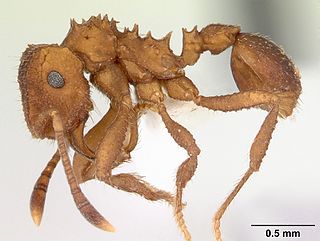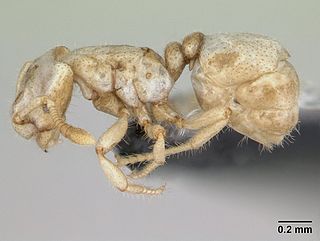
Megalomyrmex is a genus of ant in the subfamily Myrmicinae. The genus is known only from the Neotropics, where some of the species are specialized parasites or predators of Attini.

Sericomyrmex is a genus of fungus-growing ants in the subfamily Myrmicinae.

Mycocepurus smithii is a species of fungus-growing ant from Latin America. This species is widely distributed geographically and can be found from Mexico in the north to Argentina in the south, as well as on some Caribbean Islands. It lives in a variety of forested habitats and associated open areas. Two studies published in 2009 demonstrated that some populations of the species consist exclusively of females which reproduce via thelytokous parthenogenesis. A detailed study found evidence of sexual reproduction in some populations in the Brazilian Amazon. Accordingly, M. smithii consists of a mosaic of sexually and asexually reproducing populations. In asexual populations all ants in a single colony are female clones of the queen. Inside the colony, the ants cultivate a garden of fungus grown with pieces of dead vegetable matter, dead insects, and insect droppings.

Mycocepurus is a Neotropical genus of fungus-growing ants in the subfamily Myrmicinae. The genus is known from Mexico, south to Brazil and Argentina. Like other attines, they primarily grow fungi of the tribe Leucocoprini. They use many different substrates for growing their fungi, from dry leaves and caterpillar dung to fruit matter. One of its species, Mycocepurus smithii, which lives in South America, reproduces by cloning – all ants in a colony are clones of the queen. M. castrator is a parasite of M. goeldii.

Kalathomyrmex is a genus of ant in the subfamily Myrmicinae containing the single species Kalathomyrmex emeryi. First described as Myrmicocrypta emeryi by Forel in 1907, the species was most recently moved to its current genus by Klingenberg and Brandao in 2009.

Atta cephalotes is a species of leafcutter ant in the tribe Attini. A single colony of ants can contain up to 5 million members, and each colony has one queen that can live more than 15 years. The colony comprises different castes, known as "task partitioning", and each caste has a different job to do.

Atta insularis is a species of leafcutter ant, a New World ant of the subfamily Myrmicinae of the genus Atta endemic to Cuba. This species is from one of the two genera of advanced fungus-growing ants within the tribe Attini.

Trachymyrmex is a genus of fungus-growing ants in the subfamily Myrmicinae. The genus is mainly tropical in distribution, with most species being found in Central and South America.

Myrmicocrypta is a Neotropical genus of fungus-growing ants in the subfamily Myrmicinae. The genus is known from Mexico to Argentina. Their colonies are generally small, consisting of fewer than 200 individuals.

Cyphomyrmex is a genus of fungus-growing ants found primarily in South and Central America. However, some species do come up to the southern portion of North America. They grow a variety of fungi in the tribe Leucocoprineae. Most fungal gardens are grown in small nodules, some species to cultivate entire mycelium, though. Colonies are monogynous and are relatively small with about 100 workers on average.

Agroecomyrmecinae is a subfamily of ants containing two extant and two fossil genera. The subfamily was originally classified in 1930 by Carpenter as Agroecomyrmecini, a Myrmicinae tribe. Bolton raised the tribe to subfamily status in 2003, suggesting that Agroecomyrmecinae might be the sister taxon to Myrmicinae. It has since been discovered to be one of the earliest lineages of ants, a clade from the basal polytomy for all ants. In 2014, the subfamily was expanded to two tribes. The tribe Ankylomyrmini was moved from the subfamily Myrmicinae to Agroemyrmecinae.

Proatta is a Southeast Asian genus of ants in the subfamily Myrmicinae. It contains the single species Proatta butteli, known from the Malay Peninsula, Borneo and Sumatra.

Tropidomyrmex is a Neotropical genus of ants in the subfamily Myrmicinae. The genus contains the single species Tropidomyrmex elianae, known from Brazil.

Lenomyrmex is a Neotropical genus of ant in the subfamily Myrmicinae.
Megalomyrmex mondaboroides is a Neotropical species of ant in the subfamily Myrmicinae. Megalomyrmex mondaboroides occurs in lowland wet forest habitats in Panama and Costa Rica. Colonies have been collected in the nests of small attines, primarily Cyphomyrmex costatus and Apterostigma goniodes. In Costa Rica a worker was collected in a Winkler sample of sifted leaf litter.
Megalomyrmex adamsae is a Neotropical species of ants in the subfamily Myrmicinae. Megalomyrmex adamsae, known from Panama, is very similar to M. symmetochus, known from Costa Rica to Panama.
Megalomyrmex nocarina is a Neotropical species of ants in the subfamily Myrmicinae. Megalomyrmex nocarina occurs in mature wet forest habitats of the Atlantic slope of Costa Rica. It occurs from near sea level to 1110 m elevation. It is known exclusively as isolated workers in Winkler samples of forest floor litter.

Trachymyrmex septentrionalis is a species of ant in the subfamily Myrmicinae. It is the northernmost species in the tribe Attini.

Sericomyrmex radioheadi is a species of ant in the genus Sericomyrmex. Described by Ana Ješovnik and Ted R. Schultz in 2017, the species is endemic to Venezuelan Amazonia. The species is named after the British rock band Radiohead. Female members of the species have a white, crystal-like layer covering their bodies, but this layer is absent from the males.















